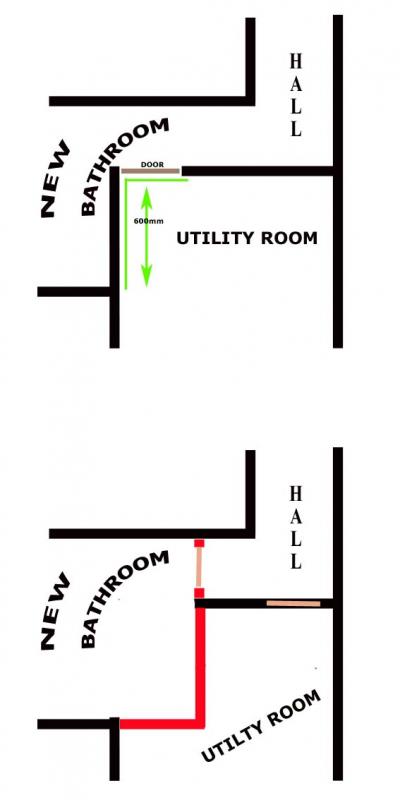Hi 
Bungalow built around 1976.
Converted to a chalet bungalow about 15 years ago (first floor added).
The section mentioned below is at the end of the property
(no habitable space above proposed removal) and falls within/below
the large "Roof Eaves" created when the rooms where squared off for
the conversion.
As you will see below I need to knock out two walls.
I have indicated the sections to be removed in GREEN.
The wall on the left has got to have 600mm removed.
The DOOR section plus 100mm has also got to be removed.
NOTHING IS TO SCALE
I have exposed the blockwork at the top of the two walls to see if load bearing.
I don't think they are load bearing for 2 reasons;
1) The plasterboard ceiling is running ON TOP of the walls I want to remove.
i.e. spans across into other rooms/space.
This tells me that the ceiling was put up first, and then the blockwork
(which is only around 3 1/2 inches wide) built after.
2) When I punchered the plasterboard I could see that the joists are not
touching the wall/plasterboard by around 1 inch.
TWO QUESTIONS
This "1 inch above the wall" is the bit that concerns me.
1) Is this normal practise to build a wall that does NOT sit closer to the joists?
2) Do you think there is any possibility that the walls I wish to remove are
load bearing - considering what I have found?
All the joists and roof trusses seem to be newish and it looks like they are not joined
in any way - inasmuch as it looks like the whole roof was new (it is a large space).
The RED lines are the new stud work
(which will be joined to the joists that are sitting around 1" above).
Any help would be welcome.
Thanks in advance.
Bungalow built around 1976.
Converted to a chalet bungalow about 15 years ago (first floor added).
The section mentioned below is at the end of the property
(no habitable space above proposed removal) and falls within/below
the large "Roof Eaves" created when the rooms where squared off for
the conversion.
As you will see below I need to knock out two walls.
I have indicated the sections to be removed in GREEN.
The wall on the left has got to have 600mm removed.
The DOOR section plus 100mm has also got to be removed.
NOTHING IS TO SCALE
I have exposed the blockwork at the top of the two walls to see if load bearing.
I don't think they are load bearing for 2 reasons;
1) The plasterboard ceiling is running ON TOP of the walls I want to remove.
i.e. spans across into other rooms/space.
This tells me that the ceiling was put up first, and then the blockwork
(which is only around 3 1/2 inches wide) built after.
2) When I punchered the plasterboard I could see that the joists are not
touching the wall/plasterboard by around 1 inch.
TWO QUESTIONS
This "1 inch above the wall" is the bit that concerns me.
1) Is this normal practise to build a wall that does NOT sit closer to the joists?
2) Do you think there is any possibility that the walls I wish to remove are
load bearing - considering what I have found?
All the joists and roof trusses seem to be newish and it looks like they are not joined
in any way - inasmuch as it looks like the whole roof was new (it is a large space).
The RED lines are the new stud work
(which will be joined to the joists that are sitting around 1" above).
Any help would be welcome.
Thanks in advance.



